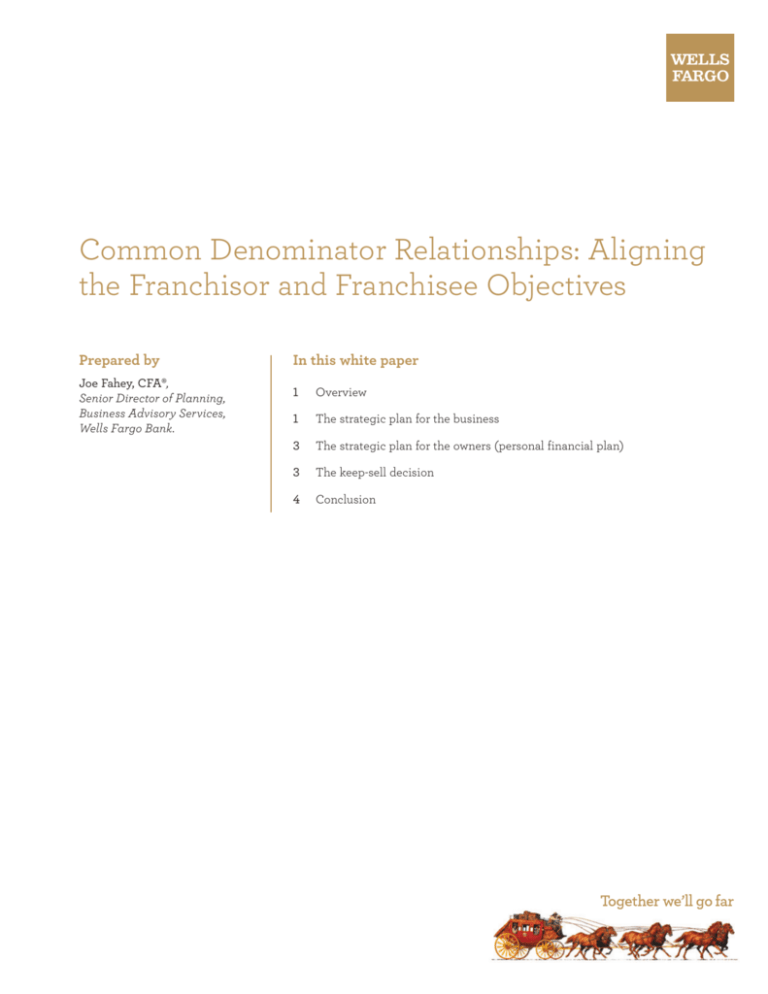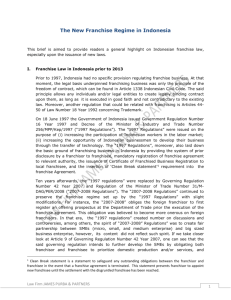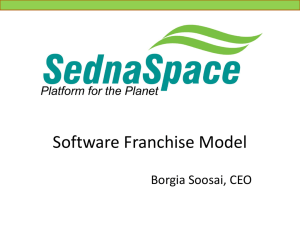
Common Denominator Relationships: Aligning
the Franchisor and Franchisee Objectives.
Prepared by:
Joe Fahey, CFA®,
Senior Director of Planning,
Business Advisory Services,
Wells Fargo Bank.
In this white paper
1
Overview
1
The strategic plan for the business
3
The strategic plan for the owners (personal financial plan)
3
The keep-sell decision
4
Conclusion
Common Denominator Relationships: Aligning
the Franchisor and Franchisee Objectives
Overview.
The strategic plan for the business.
For certain individuals who possess an entrepreneurial
spirit or who simply have a goal of being more
independent (as opposed to working as a career
employee), franchising may offer a “safer” way to own a
business and be the boss rather than starting a business
from scratch.
Shareholder value is all about gaining and sustaining
a competitive advantage, generally measured as above
average industry profits. Franchisors benefit from
converting a successful business model and gaining
scale at a rapid rate with lower risks by accelerating
their growth strategy through a distribution network of
franchisees. The efficiency of scale is shared among all
franchisor and franchisee owned entities. Franchisors
help control the client experience with marketing and
branding of the product or service. Size matters for both
the franchisor and franchisee, as it reduces average
costs and increases profit margins.
The franchise sector is expected to grow at the fastest
rate in five years.* Franchising covers nearly every
industry and trend in the economy. While franchising
has the element of “only the strong survive,” like any
other business, for those desiring to start a franchise
business, there is usually a lot of coaching built in from
the franchisor and other franchisees on how to be
successful. The franchisor offers a proven infrastructure
and market knowledge to help manage the risks of entry
and increase the chances for future success for their
franchisees. The costs and complexity of running a
franchise may be lower than creating a start-up.
In most cases, the franchisor has developed a proven
product or service and, supported by market research,
can identify locations that offer strong demographics
for success. The franchisor seeks to identify, train, and
develop a distribution network of franchisees to partner
with and execute their strategic plan. The franchise
relationship offers a strong incentive for cooperation
and a win-win partnership among all franchisees and
the franchisor. The beauty of the relationship lies in
both the franchisor and the franchisee sharing mutual
best interests and motivations for success. The leverage
is finding as many franchisees to execute on a proven
model and formula based on the market demand for the
product or service.
Just like any other business, franchisees may need help
in planning for a seamless ownership and management
transition. In this paper, we’ll examine several business
and shareholder strategies that serve as key discovery
items to help you organize and simplify the complexities
of entering into a franchisor/franchisee relationship.
1. Financing.
Franchisors gain growth and market share with “other
people’s money,” as franchisees typically pay an initial
fee and ongoing royalties to the franchisor and obtain
their own financing. The amount of debt to equity is
generally controlled by the franchisor. Financial
institutions tend to find the risks associated with
successful franchises less risky than a one-off business
in the same industry.
The potential buying power of the franchisor helps
franchisees manage costs, maintain consistency of the
client experience, and improve profitability. The key
to successful franchise growth and development is
accurate cash flow forecasting. Based on the growth
strategy, the franchisee needs to estimate operating
margins, then account for taxes, reinvestment for
capital expenditure, and working capital. Additionally,
franchisees need to stay abreast of technology and
branding changes. Maintaining property standards via
periodic renovations or branding also needs to be
included in the forecast.
The more accurate the forecast, the more likely the business
is to be profitable, and this positions the business for
additional opportunities to expand the number of
franchise locations. In the hotel space, for example, major
renovations may be required every 5–10 years. This all
*International Franchise Association, “Two Reports Show Franchise Growth Expected to Increase at Fastest Rate in Five Years,” June 2014.
Common Denominator Relationships: Aligning the Franchisor and Franchisee Objectives
1
3. Incentive.
needs to be budgeted into the forecasts. Poor forecasting
could jeopardize the franchisee’s ability to maintain the
quality standards and branding, and thus risks having
the franchisors cancelling their franchise agreement.
The saying “you get what you incent” is easily
translatable for the franchise business. The return
on investment (ROI) for both the franchisor and the
franchisee is tied contingently to the success of the
business. Both parties are highly motivated to see the
business plan executed in an optimal way. It is crucial
to reward employees for a job well done, and create a
corporate culture and working environment that allows
for career development.
2. Management and human resources.
Generally speaking, a franchisee will possess an
independent spirit needed to succeed as an
entrepreneur and a desire to transition from employee
to employer and to build their management team.
In a similar way, a franchisor should look at their
franchisees as key managers or partners and help them
build and develop each franchisee team to help execute
the overall strategic goals of the organization.
The other common saying that you “inspect what you
expect” is well entrenched in franchising by way of the
franchise agreements, which outline the “rules of the
road” and sets appropriate expectations. The franchisor
gets to approve the key management team and ownership
transitions. Sharing a fair portion of the profits with
employees, based on both quantitative metrics and
intangible corporate culture objectives, may go a long
way towards building a loyal and proud work force.
The problem with starting a new venture is that most
people lack experience in running a business and it
takes time to gain the knowledge to run a business.
With a franchise, the initial fee paid to the franchisor is
used to help the franchisee get the pre-start, initial start,
and on-going training and development, helping to
serve as a kind of soft landing into the business world.
4. Communication.
The key to success for any business is its ability to design,
communicate, and execute the strategic plan and vision. In
addition to initial training, front-end expectations, ongoing
feedback, and feed forward communication between the
franchisor and franchisee allows for proper execution on
basic fundamentals, as well as the ability to adapt to
changes in industry dynamics, customers tastes, and
desired company innovations. Quality communication
enhances the trust between the partners.
Once established, the franchisee has some flexibility,
within reason, to be creative in marketing and
positioning their business. They take responsibility to
identify, train, and develop the management and
employee base. The employee development and
transition plan may need to consider factors such as
age, demographics, and retirement plans of the current
management team. Thus, building and developing
bench strength and a strong corporate culture will aide
in the smooth transition of the business.
Strategic Plan (Business)
Business Vision and Plan
Competitive Positioning
Succession Strategy
Financing
Retained Earnings, Debt, Equity
Distribution Policy
Operating vs. Passive Assets
Entity Structure (C, S & LLC)
Legacy
Talent
Top Grading/Productivity
Demographics/Bench Strength
Corporate Culture
BUSINESS
OWNER
Incentive
Tied to Strategy
Reward and Risk Management
Keep, Sell or ESOP
Communications Strategy
2
Strategic Plan (Owners)
Personal Finance Plans
Wealth Transfer Philosophy
Private Business Governance
An Integrated
“Financial Blueprint”
Wealth
Creation
Financing
Income
Liquidity
Risk Profile
Estate Taxes
Talent
Rules for Entry
Training and Development
Compensation
Wealth
Management
Common Denominator Relationships: Aligning the Franchisor and Franchisee Objectives
Incentive
Valuation Planning
Legal Documents
Optimal Shareholder/Asset
Communications Strategy
WEALTH TEAM
BUSINESS TEAM
Integrated Strategic Planning: The Model.
For the best interest of all stakeholders, the franchisor’s
role is to ensure that both parties are mutually interested
in the success of the franchisee. The franchisor has an
obligation to remove the “bad apples” for the good of all
franchisees and revoke (or not renew) the franchise
agreements with such parties. Franchisors never want to
be in a position where they are far more interested in
the success of the franchise than the franchisee.
Additionally, most franchises have franchisee committees
and work with the franchisors to communicate up the
chain of command so that appropriate changes are made
to keep the business healthy. The better the communication
and spirit of win-win, the less likely the cross purpose
objectives and attitude of “taxation (royalties) without
representation” will permeate across the franchises.
The strategic plan for the owners
(personal financial plan).
Generally speaking, the rationale for business owners
to start and build a franchise business is to gain
independence and build financial wealth. Another key
reason for building a franchise may be to get your
children and grandchildren involved in building a
family business and legacy. Ideally, the business
succession and exit strategy of the owners begins when
the franchise agreement is signed. Thus, a financial plan
to cover all contingencies such as unexpected death,
disability or long, healthy life with transition to family or
sale to management or third party should be outlined
early and reviewed often.
1. Financing.
Oftentimes, the start-up capital and risks involved in
starting a business can be very high. With a franchise
business, there is a known business plan and financial
model, with upfront and ongoing costs (royalties),
providing a seemingly clear expectation of what is
involved in running a franchise. The rewards may not be
as high as venturing out on your own, but the risks of
failure are substantially lower. With franchising, a strong
and predictable income stream can generate income to
expand the business to nearly any size. Thus, the
opportunities for substantial wealth for you and your
heirs may be balanced with lower risks.
Just as we discussed financing for the business,
business owners also need to budget for their personal
wealth strategy. If you’re a business owner, it’s quite
likely that your business is intricately tied to your
personal wealth plan, especially in the context of your
retirement and business succession. It’s important to
build and maintain a diversified, liquid pool of assets
outside of the business. Any cash not needed to manage
the operations of the business should be invested
outside of the business to manage the risks of litigation
and to build a financial nest-egg for retirement. Gaining
core assets and cash flow to support your retirement
goals should help make the ownership transition to the
next generation more efficient and harmonious.
2. Management and human resources (family)
For some, a key motivation for owning and running a
franchise business may be the opportunity to bring your
family members into the business and grow the
business together. You may envision seeing your
children work hard and earn their place to become your
successor. The beauty of having competent and
qualified children and grandchildren join and manage
the business is that it enables you to create and cultivate
your own bench strength so that your business is set up
to operate from a long-term business perspective. Also,
the breadth and depth of experience needed to run a
business will often overwhelm many new business
owners. In pooling the talents of your collective family,
it may be that you have the skill set needed to run a
franchise successfully. A family-run franchise may also
help perpetuate the strong, long-term perspective of
the founders. Much like the franchisor, your family’s
investment in the franchise presents them with a mutual
interest and motivation in having the business succeed.
3. Incentive.
The opportunity to build and transition wealth to your
heirs can be high with a franchise business. The
franchisor balances and aligns the incentives for both
parties when the franchise agreement is fair and well
designed. The beauty of managing a successful
franchise is that you have the ability to cash in when it
comes time to retire by selling the business to your
heirs, back to the franchisor, or to another franchisee.
The incentive of the franchisees to build upon and grow
the brand ultimately helps maximize the value of the
business, and the attractiveness and readiness of the
business to be sold to another buyer.
The keep-sell decision.
The keep-sell decision for a franchise owner can be
complex. To the extent the business owner has taken
some of the profits over the years and developed a
diversified, liquid pool of assets that can provide financial
security without selling the business, this scenario can
provide the greatest flexibility for a business owner to
decide whether to keep or sell the franchise.
Common Denominator Relationships: Aligning the Franchisor and Franchisee Objectives
3
We encourage you to develop a keep versus sell
snapshot of your balance sheet (your personal financial
statement), cash flow, liquidity, and safety profile with
your financial advisor. Then compare this snapshot
against your family dynamics to determine how you can
provide a fair and equitable wealth transfer plan for your
children, grandchildren, and perhaps your favorite
charities. Think of it as a macro, multi-generational
family balance sheet, cash flow, asset protection/trust
planning. The biggest question when it comes to
business succession and wealth transfer of a franchise
business is how to divvy up your wealth among your
beneficiaries when your wealth is potentially tied up in
an illiquid, privately held franchise business.
50 percent of the value of the franchise. With federal
estate tax rates at 40 percent, and factoring in various
state and local estate taxes and other legal and
administrative costs, the amount could exceed 50
percent of the value. The costs and obligation for the
taxes are borne by the estate/family, but from a business
perspective, these costs are a “hidden liability” on the
balance sheet of the franchise, especially if most of the
wealth is tied up in the business (and owner occupied
real estate). The question that needs to be answered is:
upon the owner’s death, how do you pay 50 percent of
the value of the business, in cash, to the IRS, simply to
“stay in the game”? Generally, you can’t, and the business
may need to be sold in order to pay the estate taxes.
Often the range of valuations is more predictable in a
franchise business. This can help make the decision to
keep or sell easier. Let’s say, for example, your franchise
agreement offers you the opportunity to sell back to the
franchisor for a five time earnings multiple. Thus, an
operation that generates $1 million can be sold for
$5 million. With this established, arms-length valuation
between the franchisee and franchisor, it may create
a valuation opportunity for the family and its intrafamily transfers.
Thus, the incentive exists to begin your succession plan
as soon as possible. As you build your business plan,
you should integrate it with your personal financial and
wealth transfer plan. The earlier you begin, the greater
the possibility that you may reduce or eliminate the
estate tax exposure, and transition the business
efficiently and harmoniously. First and foremost, begin
with cash flow planning of the company and build up
the excess cash flow outside the business. Too often,
the dual cash flow modeling of business and personal
wealth begins too late, and hinders the ability of
business owners to retire and transition their business,
limiting their options.
While there are many strategies to implement a smooth
wealth transfer and business succession, some business
owners may agree that distributing the assets from the
sale of the business may be easier and more likely to
promote family harmony rather than trying to choose
one successor and incur family discord. Moreover, the
franchise agreement may dictate who may own the
business and what percentage can be owned. It may
require ownership transition to only active, employee
shareholders, which would eliminate the option to share
the business equally among family members, both
active and non-active.
In another example, let’s say mom and dad have reached
financial security outside of the business and want to gift
some of the shares of the business to their children, but
do not want to relinquish control or decision making.
They could create voting and non-voting interests in
the entity. The non-voting share may be discounted by
30 percent to a value that is 3.5 times earnings multiple.
In this situation, since mom and dad have reached
financial security, the wealth transfer planning can be
more efficient and reduce the cost to transfer their
wealth and business to the next generation.
Why is this so important? With estate taxes, the cost to
transfer the business shares could amount to more than
4
Conclusion.
You can never start too early to integrate your business
plan with your personal financial plan. A franchisor
may be able to offer best practices “on the business
of running the business,” but they are unable to share
sound principles around business succession and
personal wealth planning. Franchisors are competing
against other franchisors to attract franchisees to buy
into their growth strategy. To the extent the franchisor
encourages the franchisee to design and implement a
long-term vision that builds financial security outside
of the business, developing an ownership and
management transition plan consistent with the
franchisor’s vision, and efficiently transitioning the
business ownership and personal wealth over time is
a win for all parties. Our Business Advisory Services
team can help with your business and personal wealth
planning, beginning with a deep discovery of key facts
and objectives of both the business and personal
dynamics. We encourage you to reach out to your
relationship manager to start the conversation.
Common Denominator Relationships: Aligning the Franchisor and Franchisee Objectives
Disclosures
Wells Fargo Wealth Management provides products and services through Wells Fargo Bank, N.A., and its various affiliates and subsidiaries. Brokerage services are offered through Wells Fargo Advisors, LLC,
(member SIPC), a separate non-bank affiliate of Wells Fargo & Company. Insurance products are offered through Wells Fargo & Company affiliate non-bank insurance companies. Not available in all states.
Wells Fargo Advisors is the trade name used by two separate registered broker-dealers and non-bank affiliates of Wells Fargo & Company: Wells Fargo Advisors, LLC, and Wells Fargo Advisors Financial Network,
LLC (Member SIPC).
M&A Advisory Services are offered through Wells Fargo Advisors, LLC (Member FINRA and SIPC), a non-bank affiliate of Wells Fargo & Company.
Wells Fargo Bank, N.A. (the “Bank”) offers various advisory and fiduciary products and services. Wells Fargo affiliates, including Financial Advisors of Wells Fargo Advisors, LLC, a separate non-Bank affiliate, may be
paid an ongoing or one-time referral fee in relation to clients referred to the Bank. The role of the Financial Advisor with respect to Bank products and services is limited to referral and relationship management
services. The Bank is responsible for the day-to-day management of the account and for providing investment advice, investment management services and wealth management services to clients. The views,
opinions and portfolios may differ from our broker dealers: Wells Fargo Advisors, LLC and Wells Fargo Advisors Financial Network, LLC, Members SIPC, non-bank affiliates of Wells Fargo & Company.
This information is provided for education and illustration purposes only. Opinions represent Wells Fargo Wealth Management’s opinion as of the date of this report and are for general information purposes only.
Wells Fargo Wealth Management does not undertake to advise you of any change in its opinions or the information contained in this report. Wells Fargo & Company affiliates may issue reports or have opinions
that are inconsistent with, and reach different conclusions from, this report.
Wells Fargo and Company and its affiliates do not provide legal advice. Please consult your legal advisors to determine how this information may apply to your own situation. Whether any planned tax result is
realized by you depend on the specific facts of your own situation at the time your taxes are prepared.
This report is not an offer to buy or sell, or a solicitation of an offer to buy or sell the strategies mentioned. The strategies discussed or recommended in the report may be unsuitable for some clients depending on
their specific objectives and financial position.
©2015 Wells Fargo Bank, N.A. All rights reserved. Member FDIC. NMLSR ID 399801
WM29814 (201502038 02/15)
CAR# 0215-02758









